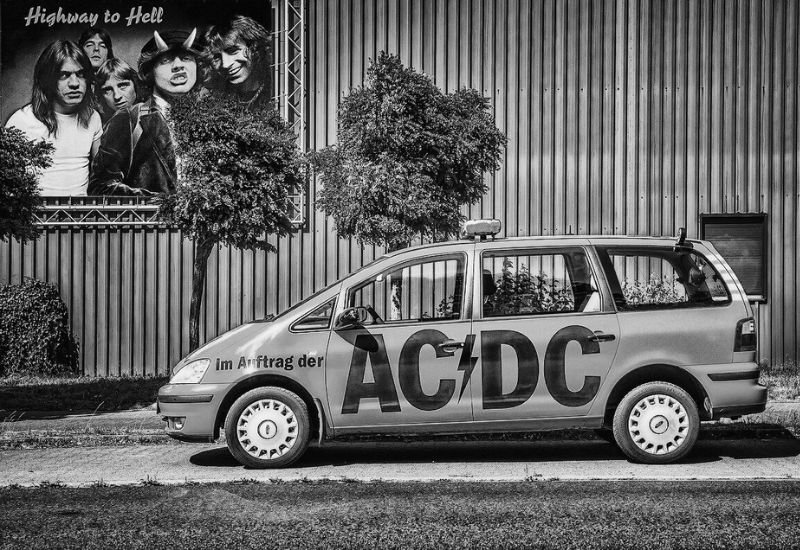When looking at pathways to net-zero, you have your classic strategies: better insulation, installing solar panels on roofs, LED lighting and smart sensors to better optimise light and indoor environments. But when did you last discuss the TYPE of electricity in the building, or did that conversation get Shot Down in Flames? This year’s Realcomm was Thunderstruck with the idea, where examples of buildings that had switched to a DC power supply were boasting up to 20% reduction in electricity usage.
Angus Young or Brian Johnson, Tesla or Edison: Why are AC and DC different and why do we use AC?
AC, or alternating current, was pioneered by Nikola Tesla (an Austro-Hungarian who moved to the US in 1884), whereas DC (direct current) was championed by Thomas Edison, the US inventor famed for the invention of the first filament lightbulb. There was a brief “War of the Currents” between the two, but eventually, Moneytalks and AC won out as it was considerably cheaper to transmit over long distances due to the ability to easily transform. As a result, AC became standard across the globe.
Switching sounds like a Highway to Hell, but is it actually a Road to Net Zero?
So why are we now talking about having buildings run on DC, if the mains all use AC?
At small distances, DC is actually more efficient – changing direction is hard work for the little electrons! But it has more to do with new technologies and requirements of buildings. The new power-saving LEDs that light your office all require a DC power supply. Your laptop you’re reading this on? It has an adapter on the charger to change the voltage from AC to DC. In fact, anything with a battery requires DC current.
The converse is true too; to store excess energy in batteries, the current needs to be DC, and the current coming from batteries is DC. Every time you convert from AC to DC (or vice versa), you lose some energy. So, every phone charger, every LED, the air conditioning unit, and particularly the increasing demand for electric vehicles that need charging, requires a transformer that loses energy.
Also, solar panels that often sit on the rooftops of large buildings produce a DC power supply (unlike traditional electricity-generating methods), so would be able to power the building directly or store its energy into a building battery without the need for conversion.
All these efficiency savings have the potential to be substantial; 20% off a yearly £500,000 electricity bill (reasonable for a large office building) is an “easy” £100,000 saved. Not only that, but battery-powered buildings allow for a building to buy electricity at cheaper rates overnight to then power the building through the day. Reducing operational costs is a challenge for all property managers and therefore should be on all their radars.
It's a Long Way to the Top (if you want a building powered by DC)
However, adopting DC is not without its issues. There have been many stories in the press about lithium-ion batteries exploding and causing fires in electric bikes and vehicles, but there are other issues.
Currently, DC systems are not Dirty Deeds Done Dirt Cheap, and have a higher installation cost due to the requirement for more specialised equipment and increased complexity. It also requires a decent amount of space and the ability to withstand some heavy apparatus within the building to convert enough incoming power in one place to power the whole building. Furthermore, as it’s only just being adopted, DC supply chains are not well established, leading to significant lead times (up to 12 months) – problematic for property managers and tenants.
Most importantly, it’s only relatively recently that it’s become an energy-saving adoption. At the time of writing this, there are only a handful of buildings in the UK trialling DC supplies, and the guidelines from the Institute of Engineering and Technology are unclear, although we are hoping for that to change in the next edition of the guidelines.
Fire regulations surrounding batteries are also still developing, so adopters need to keep a Stiff Upper Lip. Without knowing what the regulations will be, many are hesitant to spend money on something they may have to change in two years’ time.
Is it a T.N.T (Totally Necessary Transition)?
Making the switch is a big decision, and currently, it may only be worth it for larger offices and other buildings that require mainly DC power. Unfortunately, regulations are currently not up to speed, causing uncertainty among building stakeholders meaning adoption has been slow. But there are cases of it working. In the Netherlands, ABN-Amro, the private bank, has successfully implemented such a system. It’s something to be aware of, as it is likely to be retrofitted and implemented in lots of buildings in the near future.
So, Are You Ready?

